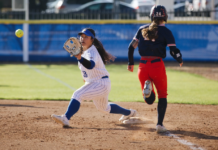
The heartbreaking passing of former NHL player Adam Johnson was confirmed in a statement released on Sunday, Nov. 29, 2023, by the Nottingham Panthers, the English side club Johnson was most recently playing for. During a UK Elite Ice Hockey League (EIHL) game against the Sheffield Steelers that took place a day prior, the fatal incident unfolded in the second period of the match when Johnson suffered an on-ice collision. The fast and brief encounter in the collision, as Christian Bennet, a Guardian journalist who was at the game, recalls, “The Sheffield player clearly got knocked off his feet and his skate went up and slit [the other player’s] throat. I’ve never seen that amount of blood come out of anyone at any sort of pace. It is one of the grimmest things I’ve ever seen at a sports event.”
The incident has been described as a “freak accident,” and while it is a rare occurrence for this level of injury, it doesn’t stop being a real possibility for athletes that play the sport. With hockey being a fast-paced sport, collisions are typical. However, adding razor-sharp skate blades to the mix means there is a higher danger factor for sustaining more serious injuries.
As the most widespread and recent injury of this magnitude, the death of Adam Johnson has catalyzed a much-needed reevaluation of priorities in hockey. This has sparked conversations about whether neck protection should be more widely mandated.
Presently, USA Hockey “recommends” rather than “requires” players to wear neck guards, a simple protective gear around the neck area. The matter could be addressed as early as USA Hockey’s Winter Meeting in January 2024 for any potential rule change proposals. Neck protectors are also not required in the National Collegiate Athletic Association (NCAA), American Hockey League or East Coast Hockey League (ECHL). For the Canadian Hockey League (CHL), which comprises three major leagues, there is a general neck guard mandate for players under 16, which is eventually lifted once they reach junior level. Moving forward, the Ontario Hockey League (OHL) and Quebec Major Junior Hockey League (QMJHL) still mandate neck guards for players, while the Western Hockey League (WHL) doesn’t. Moving up in rank, despite expecting more safety measures set in place for players performing at a professional level, the National Hockey League (NHL) has at no point in time placed a general mandate for neck protection.
Under the scrutiny of the public eye, the sport and associated leagues are being put in the spotlight, not for entertainment purposes but for long-overdue changes in safety measures. A parallel situation to that of Johnson’s is the case of 16-year-old Teddy Balkind, who died after receiving a laceration to the neck from an opposing player in an on-ice collision during a game that took place last year. Prior to that incident, there were two cases that involved NHL players that survived. The first occurred in 2008, when Florida Panthers forward Richard Zednik received a neck laceration from a teammate who simply lost balance during a game. The second case is from 1989 when Buffalo Sabres goalie Clint Malarchuk received a neck laceration when an opposing player crashed into the goal crease.
There have been a number of skate lacerations that have proved to be some of the most gruesome injuries in sports, and despite neck lacerations being rare, one is too many lives taken. As neck guards are mostly “recommended,” there are distinct reasons in favor of or against the protective gear, but it all depends on players’ personal choices.






